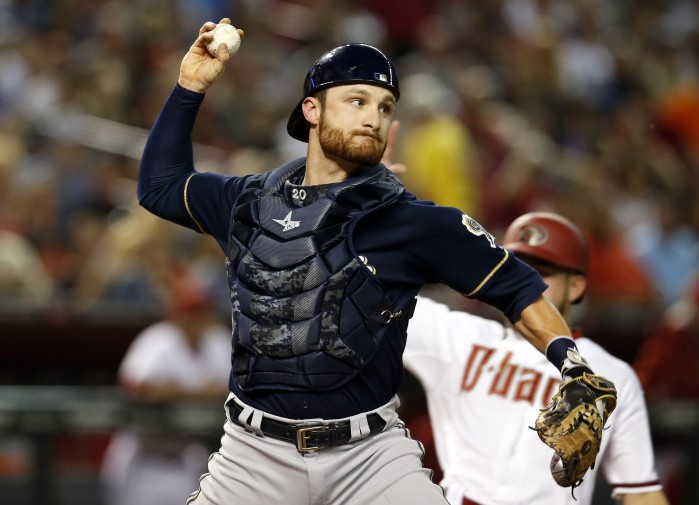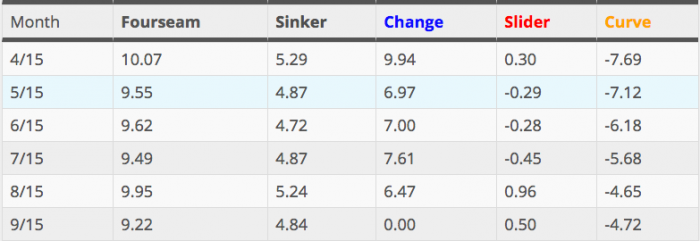RECENT SIGNINGS OPEN UP MARKET FOR KHRIS DAVIS?
With Yoenis Cespedes re-signing in New York and Justin Upton inking a long-term deal with Detroit, the stagnating outfield market seems to finally have jumped to life. Dexter Fowler and Austin Jackson still have to find homes. As the latter two are primarily center fielders, though, it’s fair to suggest that the free-agent market is meaningfully over at the corner positions. That could mean the trade market heats up over the next couple weeks.
Khris Davis compiled a .247/.323/.505 slash line with 27 homers in just 440 plate appearances in 2015. Some signs still indicate that he’s best utilized as a platoon outfielder, but in an power-depressed league, Davis’s bat carries enough value to garner 500+ PA in the right situation. Now that teams can’t acquire impact outfield bats in free agency, Brewers’ GM David Stearns should finally get nibbles on the line for the 28-year-old slugger.
The fact that Davis has four control years remaining on his contract makes him stand out from guys like Jay Bruce, who will almost certainly be shopped prior to opening day. Working against him, though, is the fact that he can only handle left field.
The Chicago White Sox are desperately looking for a reason to not start Avisail Garcia in right field (and could move Melky Cabrera to right). The Los Angeles Angels could use someone to platoon with Daniel Nava in left. A team like the Oakland Athletics may see someone like Davis as a low-cost option beyond 2016, and they’ve been haphazardly active this winter. Other teams could show interest, too, but those are a few that make sense.
JIMMY NELSON, THE KNUCKLE-CURVE, AND PLATOON SPLITS
Jimmy Nelson drew rave reviews for his early-season performance in 2015. He posted a 3.58 FIP in April and unleashed his new knuckle-curve, which buckled the knees of many spring opponents. It was a pitch designed to replace his changeup and improve his effectiveness against lefties.
In 2015, the right-hander allowed opposite-handed batters to hit .298/.381/.495 with a walk rate of 4.13 BB/9 and a 1.68 WHIP. It represented a stark difference to his performance against righties, who he dominated throughout the entire year. The existence of a cavernous platoon split suggests that his knuckle-curve wasn’t really all that it was cracked up to be.
Of course, this skirts the fact that baseball is played over six months. Consistency is perhaps more important than raw stuff. To that point, Nelson gradually lost what made his knuckle-curve so promising: the vertical tilt.
As one can see, his knuckle-curve became more horizontal and less vertical as the season progressed. And the pitch isn’t much different from his slider — aside from a bit of velocity — if it’s not breaking downward to a significant degree. It’s also less effective against lefties when it’s not dropping off the table.
Nelson allowed left-handed hitters to post a .379 and .317 batting average in June and August, respectively. Lefties also hit over .300 in September, but he only threw 19 innings due to being struck in the head by a line drive. All of the damage may not have come against the knuckle-curve; however, the decreased vertical movement allowed opposing lefties to sit on his fastball and not offer as often against the offspeed pitch.
For Jimmy Nelson to take a step forward and become a mid-rotation starter for the Brewers, either his knuckle-curve or his changeup (in which I still believe) has to become a consistent third offering. Otherwise, he’s simply going to struggle against lefties once more in 2016 and the story won’t be meaningfully different.
WHAT MAKES LUCROY’S COMMENTS DIFFERENT?
Craig Counsell (September 23, 2015): “I don’t have any grandiose speeches yet, because I do think that where we’re at it the process of building, there’s going to be painful moments still. And that’s OK. That’s what happens when you try to build something great. There’s some pain in there. It almost has to happen, that pain. And there’s still more pain coming. That’s not to scare people. But if you want something great, you’ve got to be willing to undergo some pain. It’s a big job getting to where we want to get to. It’s a big job.”
Mark Attanasio (December 17, 2015): “By doing better, I mean fielding a playoff-competitive team and one day bringing a world championship to Milwaukee. To move toward accomplishing this lofty goal, I believe we need to take a step back and build more intensively from within.”
Jonathan Lucroy’s recent comments, suggesting that he would welcome a trade, have made many Brewers fans uncomfortable. One of the common criticisms has been that Lucroy’s “expectations of losing” could negatively impact the development of the Brewers’ young pitchers, as they may resent Lucroy and not accept his mentorship. Furthermore, maybe the comments are supposedly going to foment some kind of clubhouse disfunction.
All of that smacks of fans searching for reasons why comments they don’t want to hear are somehow worthy of anger. This isn’t the case for several reasons:
- If “negative” comments from ownership and the club’s manager — meaning, comments that seemingly convey an expectation to lose in 2016 — aren’t problematic, why are Lucroy’s? That somehow a fellow player’s unbelief will rub off and stunt development? That somehow a pitcher is going to understand his manager’s rebuilding comments, but not the ones from his catcher? I really struggle to see a qualitative difference between the comments from Counsell/Attanasio and Lucroy, other than the latter saying that he wants to leave. And, of course, only one of those individuals has limitations on his patience due to the fleeting nature of player peaks. If anyone deserves benefit of the doubt in this situation, it seems to be the player who understands that he may not have many seasons left.
- Why can outsiders understand the motivations behind Lucroy’s comments, but not his fellow teammates, many of whom are likely his friends and people with whom he’s in communication this winter? Seems to me that we’re treating the young Brewers players as if they’re unintelligent or unable to empathize with their teammate.
- Lucroy is smart enough to know that his trade value is tied up in the performance of the Brewers’ young pitching staff. He’s not going to dog it, nor is he going to ignore the development of guys like Nelson, Peralta, Davies, and Jungmann. With all the articles being written about his framing decline and his decreased ability to handle pitching staffs, there’s no way that Lucroy neglects that piece of his responsibilities.
- If we’re treating Lucroy’s comments as truthful, meaning he only cares about winning and not loyalty to the Brewers, it seems to me that his only desire in 2016 will be winning baseball games — whether that’s in Milwaukee or elsewhere. I don’t think we’ve ever seen any evidence to suggest the contrary. Part of that desire to win will be maximizing the performance and development of the young pitching staff. Assuming otherwise is blatantly ignoring Lucroy’s motivations for making the original comments.
So, no, I still don’t believe Lucroy’s comments are a big deal, and I particularly despise that I’m only feeding into the narrative by devoting 1,000+ words on the topic on this site. I hope this is the end of it.

